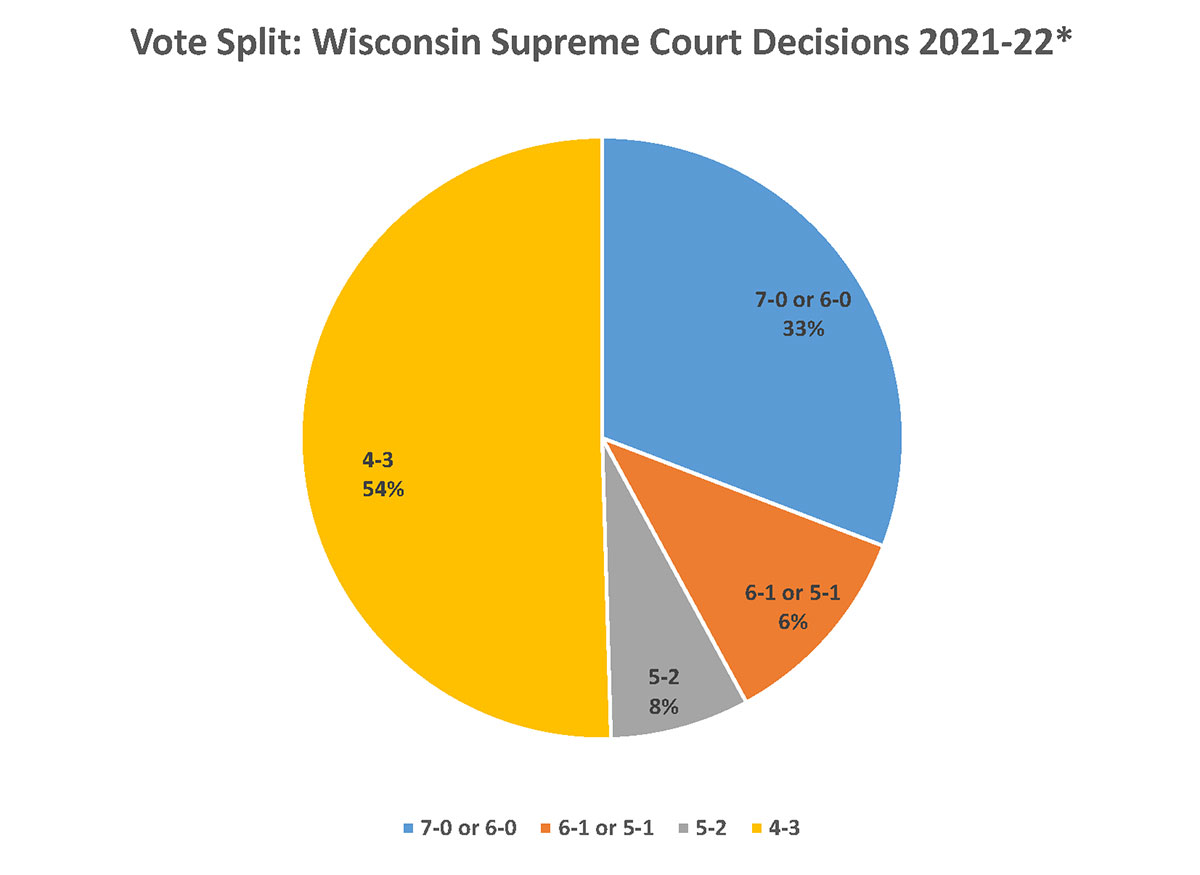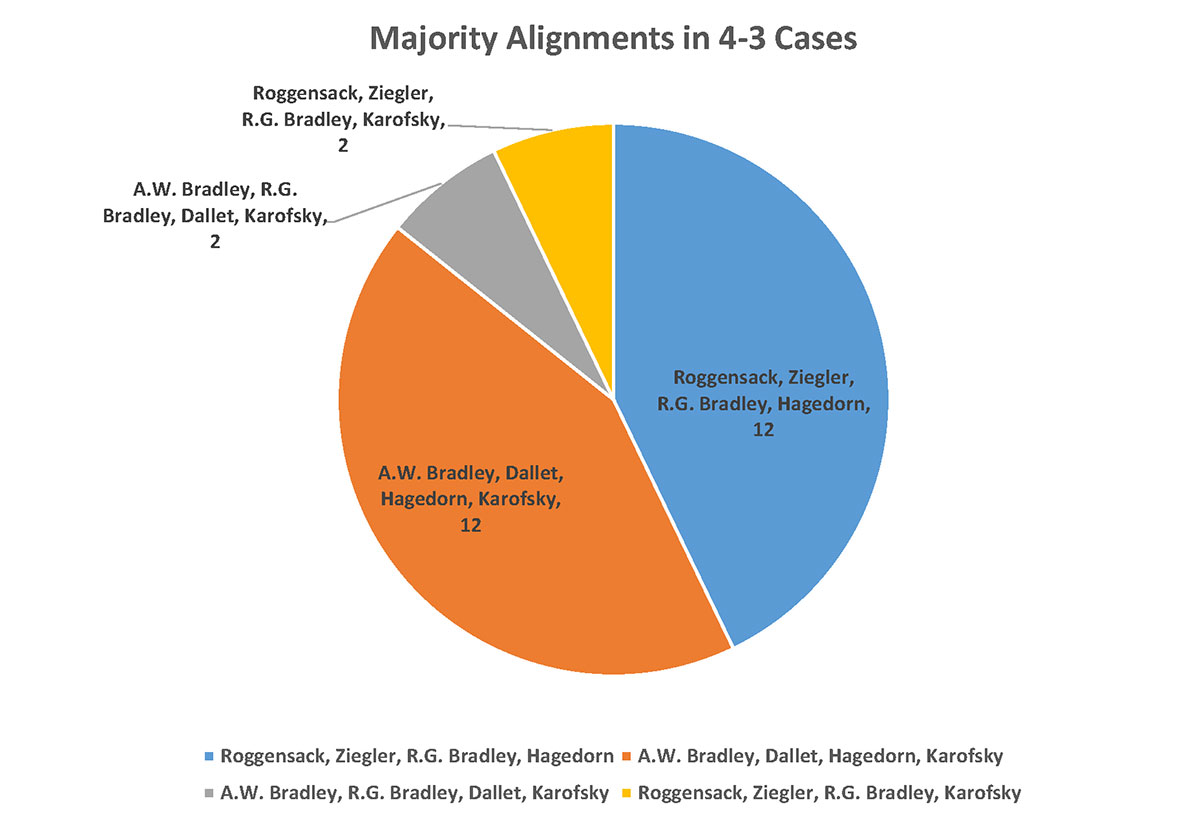
Sept. 7, 2022 – The Wisconsin Supreme Court opens the 2022-2023 term this week. As the new term starts, we look back at the 2021-2022 term and ask a legal historian, as well as a civil litigator and a former public defender for their insights.
For the third term in a row, the court decided cases challenging measures adopted by state and local government executives to combat the COVID-19 pandemic.
It also considered several election-related challenges, issuing three decisions on redrawn legislative maps and one on the legality of ballot drop boxes.
Number of 4-3 Decisions Sets New Record
The court issued 52 substantive decisions this past term (not including per curiam decisions and disciplinary decisions), one more than last term.
Thirty-seven decisions came in civil cases and
15 came in criminal cases.
More than half of the decisions, 28 (54%) were 4-3 decisions – a big jump from last term, when 19 of 51 decisions (37%) were 4-3 decisions.
Marquette University History Professor Alan Ball, who compiled the statistics used in this article, said that’s the highest percentage of 4-3 decisions in the 65 years of supreme court decisions that he has researched.
“It seems unlikely that changing our approach will result in fewer close decisions,” said Susan Tyndall, a civil litigator at Habush Habush & Rottier S.C. in Waukesha.
“As SCOWstats demonstrated, there are two blocs of judges which vote with each other in nearly all cases. However, studying the decisions, particularly the individual justices’ writings on issues similar to those litigators are bringing before the court, should help litigators develop arguments that appeal to a majority of the court.

Hagedorn Swing Justice Again
As was the case last term, Justice Brian Hagedorn proved to be the swing vote in the majority of the 4-3 decisions.
In 12 decisions, Hagedorn joined with the following bloc – Chief Justice Annette Ziegler, Justice Patience Roggensack, and Justice Rebecca Bradley – to make up the majority.
In another 12 decisions, Hagedorn joined with a different bloc – Justice Ann Walsh Bradley, Justice Rebecca Dallet, and Justice Jill Karofsky – to make up the majority.
“It’s pretty much his court on any really contentious case,” Ball said of Hagedorn. “By default, he’s the one who decides those cases.”
“Pitching arguments to Justice Hagedorn may be a successful strategy in some cases, but it will depend on the issue before the court,” Tyndall said.
“For example, in some insurance coverage cases, the court delivered unanimous decisions. Providing a strong and well-reasoned argument relying primarily on Wisconsin authority may be a stronger strategy in civil cases, which seem to result in fewer 4-3 decisions.”
The remaining four 4-3 decisions were split evenly between the following two majorities: Justice A.W. Bradley, Justice R.G. Bradley, Justice Dallet, and Justice Karofsky; and Justice Roggensack, Justice Ziegler, Justice R.G. Bradley, and Justice Karofsky.
“It shows how important Karofsky’s election was,” Ball said. “Suddenly, Hagedorn became much, much more important. It also suggests how extraordinarily important the election in 2023 is going to be, when Justice Roggensack retires.”
Bloc Alignment
Several pairs of justices anchored each bloc by consistently voting with each other.
For instance, both Chief Justice Ziegler and Justice Roggensack and Ziegler and Justice R.G. Bradley voted together in 50 out 52 cases (96%), while Justice Rebecca Dallet and Justice A.W. Bradley voted together in 49 out of 52 cases (94%).
For the cases that were decided by other than a unanimous vote, both Chief Justice Ziegler and Roggensack and Ziegler and Bradley voted together in 33 out of 35 cases (94%) and Dallet and A.W. Bradley voted together in 32 out of 35 cases (91%).
“As I mentioned earlier, SCOWstats demonstrates that there are two three-justice blocs which vote together in nearly every case,” Tyndall said. “Thus, it is hard to single out one justice as more ‘conservative’ than the rest.
“Based on these statistics, Justice Rebecca Bradley appears to be the most conservative justice this year, her opinions and dissents tracking conservative lines in all of the cases that I reviewed.”
Drop in 5-2 and 6-1 Decisions
As was the case last year, the court issued more 4-3 decisions than it did unanimous decisions. The court’s 17 unanimous decisions made up 33% of the whole; 11 came in civil cases and six came in criminal cases.
“The unanimous percentage stayed about the same,” Ball said. “What was dramatically different – what almost collapsed – were the 5-2 and 6-1 decisions.”
Of the 52 decisions, four (8%) came by a vote of 5-2 and three (6%) came by a vote of 6-1.
Ball attributed the decline in 5-2 and 6-1 decision to the frequent splits between the two three-justice blocks.
Dissents and Concurrences
Roster: The 2022-23 Wisconsin Supreme Court
Chief Justice Annette Kingsland Ziegler
- Sixteenth year on the Wisconsin Supreme Court
- First elected in 2007
- Last elected in 2017
- Faces third election in 2027
Justice Patience Roggensack
- Twentieth year on the Wisconsin Supreme Court
- First elected in 2003
- Last elected in 2013
- Reportedly not seeking reelection
Justice Ann Walsh Bradley
- Twenty-seventh year on the Wisconsin Supreme Court
- First elected in 1995
- Last elected in 2015
- Faces fourth election in 2025
Justice Rebecca Bradley
- Eighth year on the Wisconsin Supreme Court
- Appointed in 2015
- Elected in 2016
- Faces second election in 2026
Justice Rebecca Dallet
- Fifth year on the Wisconsin Supreme Court
- Last elected in 2018
- Faces second election in 2028
Justice Brian Hagedorn
- Fourth year on the Wisconsin Supreme Court
- Last elected in 2019
- Faces second election in 2029
Justice Jill Karofsky
- Third year on the Wisconsin Supreme Court
- Elected in 2020
- Faces second election in 2030
Justice Dallet penned the most dissents last term, with eight. Justice A.W. Bradley wrote seven, Justice Roggensack and R.G. Bradley each wrote six, Chief Justice Ziegler wrote five, and Justice Karofsky wrote four.
Justice Hagedorn wrote only two dissents but wrote 12 concurrences, two-thirds of the number (18) written by the other six justices combined. The justice with the next most concurrences was Justice R.G. Bradley, with five.
Elections Law Decisions
Perhaps the most high profile cases were decided in the area of election law this term. One of those cases,
Johnson v. Wisconsin Elections Commission, involved a challenge to existing legislative redistricting maps, with three court three decisions.
The court issued the first decision in November 2021. In the decision, the court ruled (4-3) that it would redraw legislative districts only where necessary to fix malapportionment between districts caused by population changes reflected in the 2020 census. Justice R.G. Bradley wrote the majority opinion, joined in full by Chief Justice Ziegler and Justice Roggensack and in part by Justice Hagedorn.
In the second decision, issued in March 2022, the court adopted (4-3) legislative maps drawn by Gov. Tony Evers, a Democrat. Justice Brian Hagedorn wrote the majority opinion, joined by Justice A.W. Bradley, Justice Dallet, and Justice Karofsky.
Several Republican legislators immediately filed an emergency appeal with the U.S. Supreme Court. Three weeks later, the U.S. Supreme Court reversed the Wisconsin Supreme Court in a per curiam decision issued on the emergency docket and remanded the case.
Upon remand, the Wisconsin Supreme Court adopted (4-3) legislative maps drawn by the legislature – maps that Evers had vetoed. Chief Justice Ziegler wrote the majority opinion, joined by Justice Roggensack, Justice R.G. Bradley, and Justice Hagedorn.
Professor Joseph Ranney, a legal historian at Marquette University Law School, said it’s unlikely that Wisconsin courts will apply many of the standards laid down in the
Johnson cases to future redistricting disputes.
“The
Johnson majority felt the ‘least change’ approach was best suited to the unique circumstances presented by the 2020 redistricting process, but the court may conclude that other approaches best fit constitutional requirements in future redistricting disputes,” Ranney said.
Ranney also said that the time pressure confronting the supreme court in
Johnson forced the court to forego a thorough analysis of whether the maps drawn by either the governor or the legislature violated the Voting Rights Act (VRA).
“In future redistricting disputes, the court may have more time for deliberation and more guidance from the U.S. Supreme Court on application of the VRA. For example, in the coming years, we will likely hear from the U.S. Supreme Court on the constitutionality of various aspects of the VRA and on whether state legislatures have unlimited power to draw Congressional districts, immune from judicial review,” Ranney said.
“Those decisions may greatly change the legal landscape of redistricting law during the next decade.”
In
Teigen v. Wisconsin Elections Commission, the supreme court struck down guidance from the Wisconsin Elections Commission that allowed local elections officials to set up ballot drop boxes. Justice R.G. Bradley wrote the majority opinion, joined by Chief Justice Ziegler, Justice Roggensack, and Justice Hagedorn.
“Election-related disputes continue to dominate the news, so I suspect we will continue to see election related decisions, though one can hope that the volume will drop,” Tyndall said.
COVID-19 Authority
The court issued three decisions resolving pandemic-related lawsuits.
In
WMC v. Evers, the court held (4-3) that a lawsuit that sought to block the release of a list of Wisconsin businesses that had at least two employees test positive for COVID-19 was barred by the state public records law. Justice Dallet wrote the majority opinion, joined by Justice A.W. Bradley, Justice Hagedorn, and Justice Karofsky.
By a 4-3 vote, the court upheld COVID-19 restrictions issued by the Dane County health officer in
Becker v. Dane County. Justice Jill Karofsky wrote the majority opinion, joined by Justice A.W. Bradley, Justice Dallet and Justice Hagedorn.
In
Colectivo Coffee Roasters, Inc. v. Society Insurance, the court unanimously held that an insurance policy that covered physical damage to property and losses caused by a suspension of operations did not cover losses caused when a coffee shop closed because of the pandemic. Justice Dallet wrote the majority opinion.

State Agency Cases
Three cases challenging state agency actions also resulted in 4-3 decisions.
In
County of Dane v. PSC, the court held that a party that issued subpoenas to a former member of the Public Service Commission failed to show specific and objective bias during an agency adjudication. Justice Roggensack wrote the majority opinion, joined by Chief Justice Ziegler, Justice R.G. Bradley, and Justice Hagedorn.
The decision in
Friends of the Black River Forest v. DNR saw the court refine an important element of the standing analysis that governs lawsuits challenging state agency actions. The court held that the “zone-of-interests” inquiry historically conducted by Wisconsin courts to help decide whether a party has standing under Wis. Stat. ch. 227 has no statutory basis.
Justice R.G. Bradley wrote the majority opinion, joined by Chief Justice Ziegler, Justice Roggensack, and Justice Hagedorn.
In
State ex relKaul v. Prehn, the court ruled that a member of the Board of Natural Resources whose term had expired was entitled to hold over as a lawful member of the board. Chief Justice Ziegler wrote the majority opinion, joined by Justice Roggensack, Justice R.G. Bradley, and Justice Hagedorn.
Public Records, Anonymous Plaintiff Cases
In two other cases decided by a 4-3 margin, the court issued decisions with significant ramifications for government transparency.
In
Friends of Frame Park, U.A. v. City of Waukesha, the court held that to recover attorney fees under Wisconsin’s public records law, a records requester must obtain a judicially sanctioned change in the relationship between the requester and the custodian of the records.
The custodian provided a requested record to the requester after the requester filed a mandamus action but before the court had ruled on the filing. The supreme court ruled that, as used in the public records law, “prevails” is a term of art that means to prevail in a lawsuit as a result of court action.
Justice Hagedorn wrote the majority, joined by Chief Justice Ziegler, Justice Roggensack, and Justice R.G. Bradley.
In
John Doe No.1 v. Madison Metropolitan School District, the court held that the circuit court did not err by requiring parents who sued a school district over its transgender policy to disclose their identities to the school district’s lawyers.
Justice Hagedorn wrote the majority, joined by Justice A.W. Bradley, Justice Dallet, and Justice Karofsky.
“These cases do highlight how significant Justice Hagedorn’s position can be on the cases that the court reviews and demonstrate that, especially in cases involving litigation against a governmental entity, attempting to persuade Justice Hagedorn may be particularly important,” Tyndall said.
“However, appellate litigators should not focus so narrowly that they fail to develop well-framed and supported arguments because in every case, they must persuade the majority of justices.”
Fees for Medical Records
The supreme court also addressed an issue that has spurred a spate of appellate litigation over the last decade: how much companies can charge patients for copies of their medical records.
In
Townsend v. Chart Swap, LLC, the court unanimously held that woman who sued a medical records software company failed to state a claim, because the company was not a health care provider under the statute that sets limits on medical records fees.
“While at first blush the
Townsend case appears to conflict with earlier decisions regarding medical records, its consideration was limited by the pleadings in that case,” Tyndall said.
“Our firm has an appeal on a similar medical records issue before the Wisconsin Supreme Court in
Banuelos v. University of Wisconsin Hospitals and Clinics Authority, which is set for oral argument on November 1. Thus, litigators should expect further development in this area of law this term.”
Criminal Cases
Fifteen of the 52 decisions issued by the supreme court last term came in criminal cases, with six of the 15 decided by a 4-3 vote.
 Jeff M. Brown is a legal writer for the State Bar of Wisconsin, Madison. He can be reached by email or by phone at (608) 250-6126.
Jeff M. Brown is a legal writer for the State Bar of Wisconsin, Madison. He can be reached by email or by phone at (608) 250-6126.
Not including the decisions that were decided unanimously, the decisions in the criminal cases featured six different majorities, including four different four-justice majorities.
“The different alignment of the justices in criminal cases highlights the importance of advancing alternative arguments when possible,” said Mike Tobin, formerly a deputy state public defender.
“Because of the plethora of cases with multiple opinions, even in cases that are ostensibly 7-0 decisions, attorneys should consider the possibility that they may need two or more viable legal theories to persuade a majority of the justices.
“Although tailoring arguments to the most-likely swing justice remains critically important, attorneys cannot safely assume that there is a reliable coalition that will join a single opinion.”
Unlike last year, only one of the 4-3 decisions in criminal cases involved the Fourth Amendment.
In that case,
State v. Forrett, the court held that the state’s OWI penalty scheme ran afoul of U.S. Supreme Court precedent that prohibits imposing a criminal penalty for a driver’s refusal to consent to a blood draw, because such a refusal is protected by the Fourth Amendment.
Justice Rebecca Dallet wrote the majority opinion, joined by Justice A.W. Bradley, Justice R.G. Bradley, and Justice Jill Karofsky.
Of the other three Fourth Amendment decisions handed down this term, one was decided unanimously and the other two were decided by a 6-1 margin, with Justice A.W. Bradley dissenting in both.
“Nimmer is seemingly the most significant Fourth Amendment case decided this term,” Tobin said. “Although all the justices agreed that the stop and frisk of the defendant was proper, the three separate opinions showed different perspectives that could affect future cases.
“Most importantly, all three opinions discuss whether a lesser quantum of suspicious circumstances can justify a stop when police are investigating a particularly serious crime. At least according to the other two opinions, the lead opinion appears to favor this ‘sliding-scale’ approach, which the Seventh Circuit has adopted.”
Tobin said the search-and-seizure cases decided this term point to potentially winning arguments in future cases.
“Depending on the type of case, either party may emphasize the relative severity (or lack thereof) as relevant to whether the police had reasonable suspicion for a stop and frisk,” Tobin said. “Also, absent suspicious gestures or police knowledge that a suspect was prohibited from carrying a firearm, the weight afforded to suspected firearm possession is likely to be a point of contention.
“The three justices who strongly dissented in
Dodson regarding use of gun ownership as a sentencing factor may similarly disapprove of police relying on gun possession as a suspicious circumstance. A defendant could conceivably succeed in this type of Fourth Amendment case if another justice agreed that the totality of circumstances did not equate to reasonable suspicion.”
In one of the 4-3 criminal decisions, the supreme court interpreted a 2007 law that provides victims of human trafficking with an affirmative defense for any offense committed as a direct result of a trafficking offense.
In
State v. Kizer, the court held that the law provided a complete defense to first-degree intentional homicide for a woman who shot and killed the man who trafficked her. Justice Rebecca Dallet wrote the majority opinion, joined by Justice A.W. Bradley, Justice R.G. Bradley, and Justice Jill Karofsky.
The
Forrett and
Kizer decisions were two of only four in which Justice Hagedorn did not vote with the majority.
“Despite the narrow holding regarding the specific statutory subsection, the
Kizer opinions may offer guidance for future cases requiring statutory construction,” Tobin said. “For example, the majority placed great emphasis on the lack of specific statutory language limiting the effect of the defense to lowering the degree of homicide.
“The majority contrasted this lack of limiting language with other provisions that specify a reduction of the charge rather than a complete defense. Conversely, the dissent emphasized the lack of any clear statutory language to abrogate the common-law rule regarding coercion as a mitigation defense.
Firearms Ownership
As it did last term, the supreme court decided two cases involving the Second Amendment right to bear arms.
In one case,
State v. Dodson, the court held (4-3) that the defendant failed to show that the sentencing judge’s discussion of the defendant’s gun ownership improperly predisposed the judge against all gun owners.
Justice Karofsky wrote the majority, joined by Justice A.W. Bradley, Justice, and Justice Hagedorn.
In the other gun-rights case,
State ex rel Doubek v. Kaul, the court held (7-0) that the state Department of Justice (DOJ) erred by revoking a concealed weapons permit (CCW) issued to a man who was convicted of disorderly conduct after threatening his wife.
The case turned upon the interplay between the state statute that defines disorderly conduct and a federal statute that prohibits DOJ from issuing a CCW to person convicted of a misdemeanor crime of domestic violence.
In her concurrence, Justice Karofsky wrote that while the majority opinion was legally correct, the “result is as nonsensical as it is dangerous.”
Tobin said the holdings in
Dodson and
State ex rel Doubek v. Kaul suggest that defense lawyers should raise Second Amendment issues whenever possible.
“Although the narrow
Dodson majority did not find that the sentencing court improperly relied upon gun ownership, their opinion assumed that such reliance would have been improper. In a different context, such as a suppression motion challenging a search or arrest, the defense may have a persuasive argument that information about gun possession was irrelevant. “
According to Tobin, the two decisions hold lessons for police and prosecutors too.
“In documenting reasons for a search (such as in a warrant application), police and prosecutors are well advised to present additional information,” Tobin said. “Factual issues may arise regarding what police did or did not know about the suspect’s criminal record and/or license to carry a concealed firearm.
The
State ex rel Doubek v. Kaul decision, Tobin said, entails specific implications for domestic violence cases.
“Doubek is important for cases alleging domestic violence: a conviction for disorderly conduct will not result in a ban on firearm possession, even if the alleged facts could have met the federal criteria for such disqualification.
“A conviction for misdemeanor battery of a domestic partner meets the federal criteria, so the difference between the consequences often provides a strong incentive for the defense to seek a plea negotiation for amendment to disorderly conduct.”
Endnotes
1 Most of the holdings displayed in the table were summarized by Marquette University Law School Professors Daniel D. Blinka and Thomas J. Hammer, and were originally published in the Supreme Court digest that appears in
Wisconsin Lawyer.™
